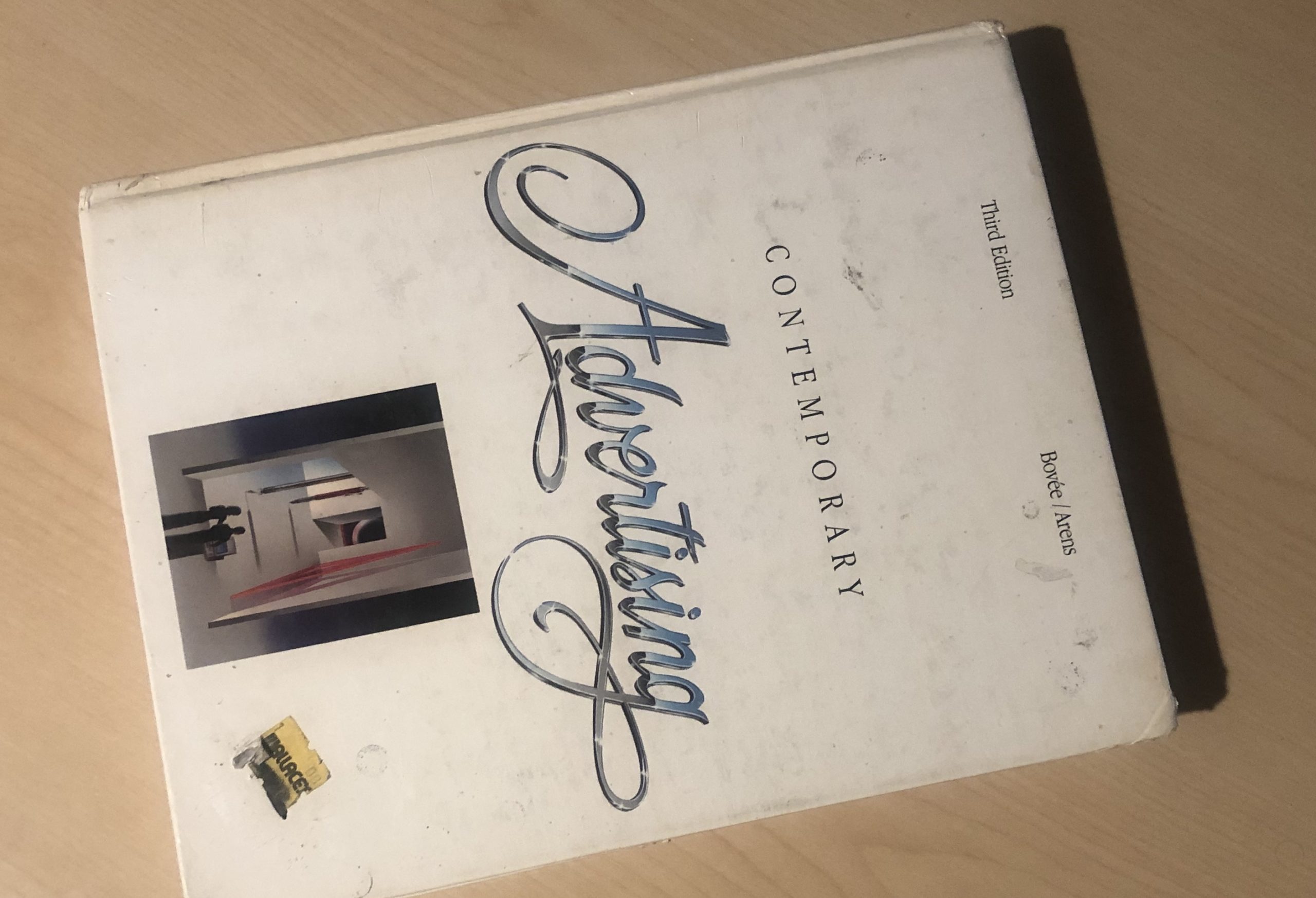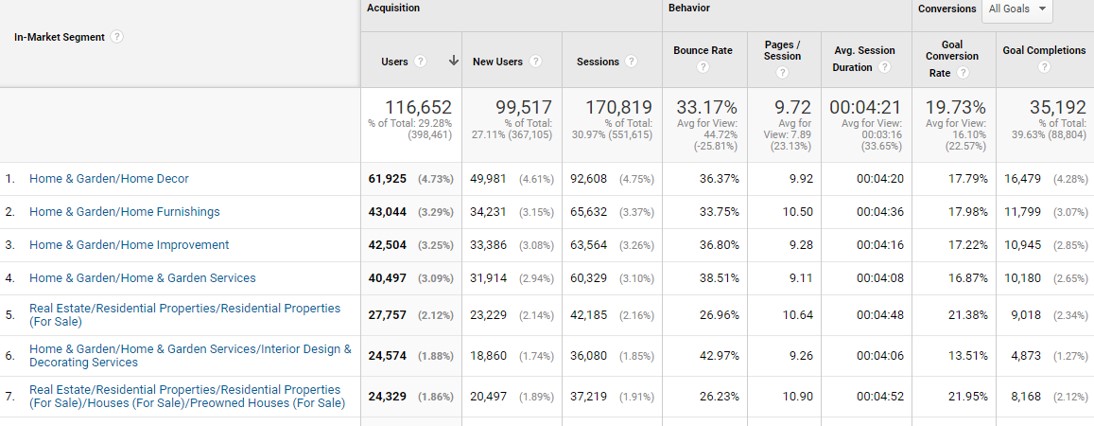Most PPC professionals today weren’t taught how to run paid search campaigns in school (or if any training was received it proved to be very basic and limited).
On top of that, we have no choice but to think about advertising in ways most of us were never taught at an academic or professional level.
 My college advertising textbook from 1992
My college advertising textbook from 1992PPC is always evolving, so we must think differently.
This doesn’t just mean “embrace automation – don’t fear it” (although that is a part of it).
Most of us who’ve been in advertising for a number of years were taught to manage key elements of a campaign.
Now the ways we were all taught have changed dramatically.
Below are five examples.
1. A/B Testing
It’s always been relatively simple: You test one creative vs. another; both going to a similar audience with comparable market conditions.
The technology to deploy, measure, and rapidly “promote a winner” from the test certainly improved dramatically over the years, but the general concept of an A/B experiment remained the same.
Today, there’s really no “champion/challenger winner” when you’re advertising within platforms using machine learning to assemble different pieces of the ad (headline, copy, extensions, etc.) and find the right copy variation based on the audience and search intent.
Plus, you can get more ad copy variations than the human mind can possibly manage (Approximately 32,000+ for Microsoft Ads and 43,000+ for Google Ads).
In the old days (like, just a couple of years ago) when testing, one of the variations might perform poorly while the other still gave you a solid, if not decent return.
Today, if you’re using Responsive Search Ads (RSA) to find that ideal combination of headlines, copy, extensions, callouts, etc., patience is required because that period during the “learning” portion of “machine learning” is brutal in terms of performance.
2. Audiences
Advertisers have always been taught to:
- Find your audience(s).
- Understand your audience(s).
- Craft the right messaging that compels your audience to action.
The reality for generations of advertisers has been limited capabilities to reach and message those audiences.
Sure, direct response marketers have long had access to segmented lists of qualified customers based on all kinds of data (age, income level marital status, purchase data), but the ability for actual advertisers to display a promotion or answer a query to only a specified audience has never existed to the extent it now does.
So many advertisers are still learning how to harness the true power of audience targeting capabilities as part of their overall campaign strategy (and I include myself among them).
 In-market audiences as seen in Google Analytics
In-market audiences as seen in Google Analytics3. Contemplating & Taking Action on Purchase Journey Insights
The concept of the “Purchase Journey” is not new at all.
Whether you call it funnel, a journey, or even a flywheel is (in my opinion) less important than developing an understanding of how your customer behaves at different stages of a purchase decision and understanding how you can help them along the way.
Marketers and advertisers have been able to see and analyze some form of digital analytics data for a generation now.
But the challenge has always been finding “actionable insights” vs. just “well, that’s interesting.”
A couple of examples of capabilities the emergence of ad-platform machine learning has enabled:
Actions to Be Taken From the Mountains of Data No Human Brain Could Possibly Sift Through (Especially Mine)
For instance, which combination of headline, copy, and link are best displayed to a specific audience with clear intent to purchase vs. just research options?
I have a hunch, but the ad platform has data.
Data wins.
Actionable Insights Into Niche Audiences You May Never Have Even Considered
Every advertiser will have obvious audiences to target (and you should), but assume your competitor is also smart enough to go after that same pool.
For instance, you’re targeting boating and fishing enthusiasts with ads for waterproof cases that protect your device while allowing full functionality. That’s obvious.
What may not be so obvious at first glance is that football coaches also use this product since they have to be on the sideline during all types of weather – not just clear skies.
4. Exercising Campaign Control – Gains & Losses
Many PPC practitioners feel they have less control than they did three years ago.
They’re correct.
Others feel a sense of greater control.
They’re also correct.
Huh?!?
How’s that work?
When Google Ads ignores your negative keyword (yup – seen it happen) because the machine learning algorithm has determined the intent of the searcher justifies showing your ad, your forehead can get sore from banging it on the desk.
It’s extremely frustrating to feel ignored like that and explain to a client or boss why your negative keyword may have been ignored.
PPC marketers are usually hardwired to seek as much control as possible over campaigns where real budget dollars and the potential for wasted spend are on the line.
Most have been trained to exercise tight control over keywords and match types and it’s clear they now have less ability to.
On the flip side, I would argue there are things you now have greater control over which should excite anyone buying ads.
Control Over Who Gets Shown Your Ad
As noted in point 2, you have control over who gets shown your ad.
You’ve always known all keyword queries (of the same phrase) are not created equal and in the past, that was incredibly frustrating.
Now you have an ability to determine exactly how bad you want to respond to a query from a highly qualified audience segment.
You set the conditions and have the control you did not before.
Control Over Creative Inputs
Even in a world of RSAs, you have control over what creative inputs you will “allow the machine to assemble” when making an ad.
It won’t (at least not yet, anyway!) insert any creative content you don’t provide.
This is a different way of writing ads than you were probably taught (it certainly is for me).
You were probably taught to look at “how the entire ad works as a whole.”
I was.
Now, to be successful in this new world, you have to look at “what individual pieces will make sense to try in each specific part of the ad (1st headline, 2nd headline, copy, callouts, sitelinks, etc.) when assembled by a machine trying to figure out the best combination”.
Those are different ways of looking at building an ad.
5. Cost Per Acquisition (CPA) Goals
The ability to target specific audiences for campaigns should change how you look at cost per acquisition goals.
Previously, most PPC campaigns would measure CPA for branded and non-branded.
More sophisticated ones would break out the measurements further (for example CPA by Ad group).
Any PPC success metric (cost per acquisition, return on ad spend, etc.) needs to look beyond just the last click for determining which marketing tactics work throughout the purchase journey, but that’s a subject for another post.
The point I’m trying to make here is that if you’ve determined who your top priority is in terms of audience target, they are so for a reason.
You probably have a good idea of the lifetime value (LTV) of a typical customer from that specific audience.
Now, if you have a secondary audience that isn’t your top priority because “this type of buyer” just isn’t as valuable of a customer, you’re probably not willing to pay as much.
That is completely fine and frankly how it should be!
You have the ability to structure your account to allow you to have one CPA goal for one segment and a different success metric for another.
Bonus Thought: What You Need to Hang Onto
The importance of strategic thinking and sound ad copy principles doesn’t go away – in fact, it’s more important than ever.
Think of your job like this:
You have a super-powered machine learning platform made available to you to do all the heavy lifting dirty work every smart PPC marketer always wished was humanly possible.
It’s not, so instead, you have a machine to literally do your bidding for you.
However, the outputs you get from “that machine” will only be as good (or bad) as the inputs you provide.
If you’re interested in a primer on tried and true principles of ad copy, here’s a post I wrote in August 2018.
More Resources:
- 7 Out-of-the-Box PPC Advertising Ideas You Should Try Now
- 5 Innovative PPC Tactics to Try Today
- Top 10 Must-Try PPC Tactics This Year
Image Credits
In-Post Image: Provided by author
Screenshot taken by author, May 2020





